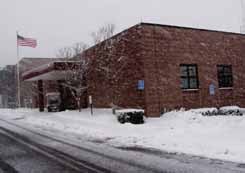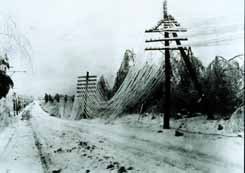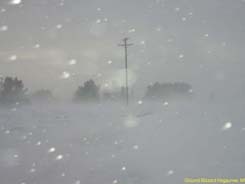
Everyone is potentially at risk during winter storms. The actual threat to you depends on your specific situation. Recent observations indicate the following:
Don't get caught in a winter storm. The results can be fatal. Death can be caused in a number of different ways.
- Deaths related to ice and snow: -About 70% occur in automobiles.
- Deaths related to exposure to cold: -50% are people over 60 years old.
-About 25% are people caught out in the storm.
-Over 75% are males.
-About 20% occur in the home.
FROSTBITE
Frostbite is damage to body tissue caused by that tissue being frozen. Frostbite causes a loss of feeling and a white or pale appearance in extremities, such as fingers, toes, ear lobes, or the tip of the nose. If symptoms are detected, get medical help immediately! If you must wait for help, slowly rewarm affected areas. However, if the person is also showing signs of hypothermia, warm the body core before the extremities.
HYPOTHERMIA: LOW BODY TEMPERATURE
Warning signs - uncontrollable shivering, memory loss, disorientation, incoherence, slurred speech,drowsiness, and apparent exhaustion.
Detection - Take the person's temperature. If below 95F (35C),immediately seek medical care! If medical care is not available, begin warming the person slowly. Warm the body core first. If needed, use your own body heat to help. Get the person into dry clothing, and wrap them in a warm blanket covering the head and neck. Do not give the person alcohol, drugs, coffee, or any hot beverage or food; warm broth is better. Do not warm extremities (arms and legs) first! This drives the cold blood toward the heart and can lead to heart failure.
WIND CHILL
The wind chill is based on the rate of heat loss from exposed skin caused by combined effects of wind and cold. As the wind increases, heat is carried away from the body at an accelerated rate, driving down the body temperature. Animals are also affected by wind chill.

Storms with Strong Winds
Sometimes winter storms are accompanied by strong winds creating blizzard conditions with blinding wind-driven snow, severe drifting, and dangerous wind chill. Strong winds with these intense storms and cold fronts can knock down trees, utility poles, and power lines. Storms near the coast can cause coastal flooding and beach erosion as well as sink ships at sea. In the West and Alaska, winds descending off the mountains can gust to 100 mph or more damaging roofs and other structures.
Extreme Cold
Extreme cold often accompanies a winter storm or is left in its wake. Prolonged exposure to the cold can cause frostbite or hypothermia and become life-threatening. Infants and elderly people are most susceptible. What constitutes extreme cold and its effect varies across different areas of the United States. In areas unaccustomed to winter weather, near freezing temperatures are considered "extreme cold." Freezing temperatures can cause severe damage to citrus fruit crops and other vegetation. Pipes may freeze and burst in homes that are poorly insulated or without heat. In the north, below zero temperatures may be considered as "extreme cold." Long cold spells can cause rivers to freeze, disrupting shipping. Ice jams may form and lead to flooding.
Ice Storms
Heavy accumulations of ice can bring down trees, electrical wires, telephone poles and lines, and communication towers. Communications and power can be disrupted for days while utility companies work to repair the extensive damage. Even small accumulations of ice may cause extreme hazards to motorists and pedestrians.
Heavy Snow Storms
Heavy snow can immobilize a region and paralyze a city, stranding commuters, stopping the flow of supplies, and disrupting emergency and medical services. Accumulations of snow can collapse buildings and knock down trees and power lines. In rural areas, homes and farms may be isolated for days, and unprotected livestock may be lost. In the mountains, heavy snow can lead to avalanches. The cost of snow removal, repairing damages, and loss of business can have large economic impacts on cities and towns.
 Print
Print Email
Email








